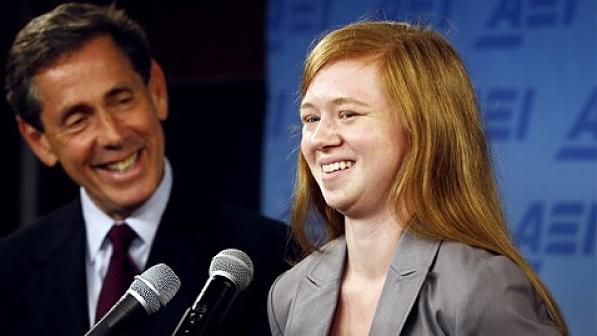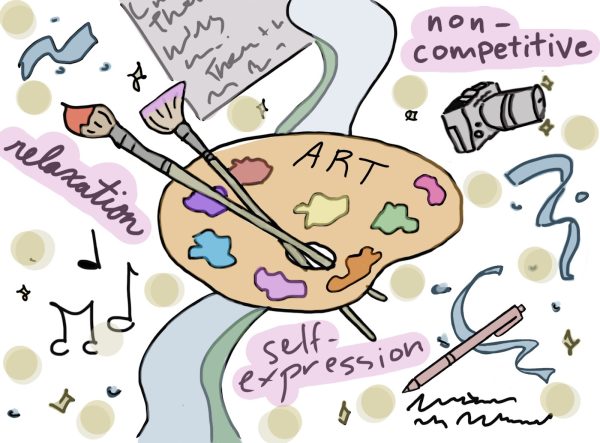Racing to the past
Why I cannot affirm Affirmative Action

Abigail Fisher applied to University of Texas at Austin in 2008, was rejected and went to Louisiana State University. Photo courtesy of ABC News.
The Supreme Court recently heard Fisher v. University of Texas – a case in which plaintiff Abigail Fisher argued that she was denied admission into University of Texas at Austin because of the college’s selection process.
The university uses racial preferences under the updated Ten Percent Program of 2003. Minority students with the same merits as Fisher got into University of Texas at Austin, according to University of Texas at Austin’s 2008 admission statistics.
Fisher’s case strongly indicates the damage done by affirmative action programs to society’s fight against racism.
According to Civilrights.org, affirmative action’s goal is to give “everyone an equal break,” but affirmative action has evolved into a counterproductive measure.
Affirmative action throws merit out the window. As a result, some minority students who are admitted into rigorous schools solely on the basis of their race prove not to be well fitted and end up struggling in college, according to a UCLA report by David Sanders.
By choosing to focus on a student’s race rather than on the student’s merit, affirmative action deems race as a qualification to be accepted to a college. This policy is demeaning to the individual as it overshadows the value of the student’s merits and insults what the student has achieved throughout high school. Affirmative action looks at the color of an individual’s skin rather than the content of that person’s character.
While it is true that minority races on a college campus can bring diversity to the campus, students with different economic statuses bring a more valuable kind of diversity.
Proponents of affirmative action contend that different races expose minority students to different cultures, making race diversity in a school important. However, the personal essay section of each college application shows the uniqueness of each student. A simple race check box cannot determine the uniqueness of a student’s experience.
Now, modifying affirmative action from being based on skin color to economic status is no perfect solution. However, the latter eliminates the racism that is evident in affirmative action.
An affirmative action based on race is not only racist, but also has adverse affects on students’ future plans should they apply to graduate school. There is no good reason to have such a counterproductive system when we as a society are attempting to end racism.











Anonymous • Oct 26, 2016 at 5:36 pm
I strongly agree. I hate how people value race more than academic achievement. Abigail Fisher had average stats imo (3.59 GPA, 1180 SAT), but also top 12% of her class. I honestly feel like affirmative action is ploy by the party elites who use the African America population to discriminate against Asians. It is outrageous and demeaning to an individual’s achievement. It is sad because the public colleges have lower acceptance rates because of less funding, and with that, state-sponsored racism. If there are people who argue that minorities need a boost, this measure is telling them that they are inferior and should get easier admission. This is all done for political interest and political benefit, shameful to our society. I find affirmative action a disgrace and an insult to fairness and meritocracy.
Glenn • Jan 9, 2016 at 9:13 pm
I know I am saying a lot and very opinionated one this subject. But in the end if we want to help minorities because they are statically more likely to be economically challenged. If we want to help people who are economically challenge to get to college regardless of race.
Paul is a sjw • Dec 20, 2015 at 3:52 pm
The only long lasting effects of racism that wouldn’t be solved through everyone being color blind is economic, as non Asian minorities are often less wealthy than their Asian and white counterparts. Thus affirmative action based on wealth alone would counteract that and not support wealthy black kids that were given help every possible step along the way with tutors and SAT classes over a poor white kid that had to work to help support his family and could not afford any extra help.
Glenn • Dec 21, 2015 at 5:30 pm
Why is it necessary to force manditory diversity. The American economy is based on the equal opportunity not equal outcome which is the only thing that affirmative actions will create. I personally believe that more can be done to help those who are not as well off. But the fundamental flaw of affirmative actions is that it puts value on race or socio-economic status which are thing that should not affect one’s chances for college/job position. Race shouldn’t matter.
Adam • Dec 25, 2015 at 8:59 pm
Paul can you clarify what you are saying? What evidence do you have that that “non Asian minorities are often less wealthy than their Asian and white counterparts.” Also, note that “Asian” is also a minority and not an ethnicity. Also, by your logic you think that the son of a wealthy black daughter or Obama’s daughter should be afforded more opportunities than a Vietnamese Refugee who came here on a boat? How does that make any sense?
Certainly, Asians and Whites have higher incomes and greater wealth than Hispanics and African Americans. But it didn’t start out that way. Asians that just came to this country and disproportionately very poor, especially in comparison to their other racial counterparts. But what proponents of affirmative action like you fail to realize is that you can work harder, despite your race or ethnicity, to boost your SAT score, your GPA, or your extracurriculars/leadership experience. But you can’t work harder to change the color of your skin. The race of the Applicant is something outside of his or her control, something they can’t work harder to “fix” or get better at. As such, any reasonable person would agree that the race of an applicant should not be held against him.
The only possible justification left, Paul, for people to use affirmative action then is if they believe that some people are inferior based on the color of their skin. Is that what you hold then, Paul? Do you think that Blacks and Hispanics need to be treated differently because they have lower mental capacity and they need more help? And even if you treat them differently, how do you explain the fact that doing so compromises the very significant achievements of blacks and hispanics obtaining post-graduate or doctoral degrees? What if people dismiss their hard work as simply a byproduct of Affirmative action. What do you say to Clarence Thomas or Ben Carson, brilliant black individuals that are ashamed of their alma mater because of affirmative action.
Paul, we’re not saying that blacks and hispanics are the same as whites. That’s not true. We are saying, though, that people should be treated the same regardless of the color of their skin. The last time we failed to do that resulted in Jim Crow. Do you really want to return to that era?
Angie • Jan 6, 2016 at 5:28 pm
I don’t think that affirmative action is racist because it implies that people of color need more help. People of color (specifically Latinx and African American people who faced and do currently face a great deal of racism and prejiduce). Affirmative action, which was once intended end racial bias, has created more because now white people can unfairly blame people of color for “taking their spot” even if they do not know what truly happened.
Glenn • Jan 7, 2016 at 9:50 am
But how does that not put a value on race, you are making on race more “valuable” then the other. White students have to get to college on their merits why should color student be treated any different. I am perfectly fine with idea helping students no matter the race get to college, but we should not effect the process of admittance. A student should be admitted to college for their skill, intelligence, etc not their race.
Glenn • Jan 7, 2016 at 9:55 am
The reason a student is admitted into college should not be their race, it should be their merit. Why should a student be judged on something they cannot change? You can change your merit but you can’t change your race. The point being is that a students ability should determine whether or not they get into college, Not their genetics.
Adam • Jan 20, 2016 at 10:04 pm
Angie, I’m sorry but that is exactly what affirmative action entails. Giving people a lower criterion for admissions carries the exact implication that they need more help. If they are of the same capacity, the would be treated equally; and if they are of higher capacity, they would be met by a tougher standard. But in admissions, blacks and hispanics are not treated equally or to a higher standard – instead they are treated to a lower standard. The logical deduction then, is that they need more help. On that point, you are completely wrong.
And also, sorry to be a nitpick, but Latin is spelled “Latin” and not “Latinx.” I also believe you are referring to “Latinos, Latina’s, Latin-Americans, or Hispanics?” Am I safe to assume that?
“People of color (specifically Latinx and African American people who faced and do currently face a great deal of racism and prejiduce).” Really? Firstly, you spelled “Prejudice” wrong. Secondly, I don’t know what world you are living in, but there is no more Jim Crow, no more school segregation, and no more slavery. Instead, there is mandatory school busing, absurd redistricting (to accommodate minorities), and now the disgusting byproduct that is affirmative action. People of “color” do not face a current deal of racism. You could make the argument that they are economically worse off, but that is not the same thing that as institutionalized racism.
On the point that “people of color” have faced racism. Yes, I certainly agree with that. But do you think that the ones who oppressed blacks in the 1960’s are applying for college right now? Obviously not. So should we punish their descendants, their children’s? The only country in the world that regularly punishes people for the “crimes” of their parents and grandparents is North Korea. That is a totalitarian regime. If you support punished people based on what their ancestors did, then you are supporting a totalitarian regime’s practices.
Depending on what you mean by “people of color” and whether or not it includes Asian Americans, then yes I would agree that “people of color” are currently facing racial discrimination. It’s called affirmative action and it’s terrible.
“Affirmative action, which was once intended end racial bias, has created more because now white people can unfairly blame people of color for “taking their spot” even if they do not know what truly happened.”
–> I really have no idea what you mean here. I’m stumped, and I really tried.
Please start looking at the facts before you advocate for racism.
Paul • Dec 19, 2015 at 1:28 am
Well written article, thanks.
It seems like your central argument against the current affirmative action program is that it counteracts our attempts at ending racism as a nation. Essentially, you’re arguing that, in order to curb racism in this country, we need to be “color blind.” Being “color blind” certainly sounds appealing in theory, but it’s really just an easy way for the privileged (mainly white) folk to disregard the presence of both covert and overt racism that has been enacted unto people of color throughout the history of this country. “Color blindness,” believe it or not, actually contributes more to a racist society than does “color perception.” It invalidates people’s identities, and it simplifies white people’s understanding of diversity.
I’m not saying that maybe an affirmative action that is primarily based on economics is better or worse than the current state of the program. I’m just saying that being “color blind” is not necessarily as good as it sounds. In order to fight racism, we really have to acknowledge the many disadvantages that other races face in our nation.
Glenn • Dec 20, 2015 at 2:32 pm
I have no idea where you get this Idea that “color blindness” is away of ignoring racism. It is in no way a method of ignoring racism, It is away of treating people with the same standard no matter what race, ethnicity, or culture. I will acknollege that those factors shape you identity but not treating you based on race doesn’t ignore your identity. The reason as some who supports equality among races is against any form of affirmative actions is that it is not truly equal. You are in no way raising the chances of an minority student admissions with affirmative actions. You are instead lowering the chances of those labelled as “privileged”. We cannot sacrifice the equality of a meritocracy for equal outcome. We can do more to help those who aren’t “privileged”. We can acknollege racism and still be “Color blind”. The reason feel that affirmative action is racist is because it make race a factor in how some is chosen.